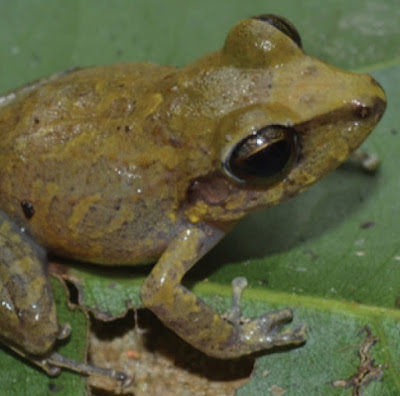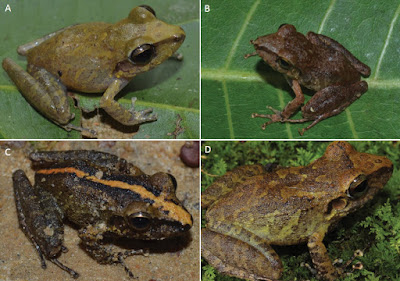[Most Recent Entries] [Calendar View]
Wednesday, August 2nd, 2017
| Time | Event | ||||
| 12:51p | [Herpetology • 2017] Pristimantis latro • A New Species of Pristimantis (Anura, Craugastoridae) from eastern Brazilian Amazonia
Abstract In this study a new species of Pristimantis (Anura: Craugastoridae) of the P. conspicillatus species group is described. Pristimantis latro sp. n. is known only from the municipalities of Altamira, Anapu, Brasil Novo, Medicilândia, Uruará and Aveiro (Flona Tapajós, right bank of Tapajós river), in Pará state, Brazil. Morphologically, the new species distinguishes from known congeners in the group mainly by the presence of dorsal tubercles and absence of discoidal folds, smooth belly skin, as well as the presence of supernumerary tubercles on hands. The call of the new species consists of seven ascending notes, the first of which has a dominant frequency of 2635 Hz and the last 3272 Hz. Molecular analysis of the 16S mtDNA indicates a genetic distance of 8% to P. chiastonotus, its closet relative, and between 9% and 11% to populations of P. fenestratus. Keywords: mitochondrial DNA, Pristimantis latro sp. n., systematics, Terrarana
Pristimantis latro sp. n. Diagnosis: Pristimantis latro sp. n. is distinguished from other species of the group by the following combination of characters (summarized in Table 4): (1) dorsal skin weakly shagreened or smooth, dorsal tubercles present, dorsolateral folds absent, smooth skin on belly; (2) whitish or yellowish ventral coloration with black spots; (3) one subarticular tubercle on fingers I and II and two on Fingers III and IV; (4) supernumerary tubercles present at the base of fingers I, II, and III, and almost the same size of subarticular tubercles; (5) lateral fringes along fingers; (6) supernumerary tubercle present at the base of Toe IV; (7) basal webbing between toes and weak lateral fringes on toes; (8) twenty-one molecular autapomorphies for the gene fragment 16S mtDNA (Table 5); (9) call consisting of seven notes. Etymology: The specific epithet “latro” (from the Latin latro = mercenary, robber) refers to the common name generally attributed to the species of Pristimantis – “Robber Frogs” – that exhibit a dark band on the snout, creating the illusion of a robber’s mask. Distribution, ecology, and habitat: Pristimantis latro sp. n. has been recorded in the municipalities of Anapu, Senador Jose Porfirio, Altamira, Medicilândia, Brasil Novo, Uruará and Flona Tapajós regions located in the interfluves Xingu / Tapajós and Xingu / Tocantins - Araguaia in Pará State, Brazil (Figure 7). It can be found in conserved areas of forests (Anapu, Flona do Tapajós) or with some environmental disturbance, e.g., forest fragments surrounded by pastures (Brasil Novo, Altamira and Vitória do Xingu). During the rainy/reproductive period, the males move up the vegetation to vocalize at a height of 1.5 m and in the dry period they can be found in the leaf litter. Elciomar Araújo De Oliveira, Luis Reginaldo Rodrigues, Igor Luis Kaefer, Karll Cavalcante Pinto and Emil José Hernández-Ruz. 2017. A New Species of Pristimantis from eastern Brazilian Amazonia (Anura, Craugastoridae). ZooKeys. 687; 101-129. DOI: 10.3897/zookeys.687.13221 | ||||
| 4:42p | [Botany • 2017] Kaempferia noctiflora • A New Species (Zingiberaceae) from Northern Thailand
Abstract Kaempferia noctiflora, another precocious flowering species of Kaempferia subgen. Protanthium (Zingiberaceae) from Northern Thailand is described and illustrated. Pure white flowers with nocturnal anthesis and a tinged purplish red patch along the midvein of the upper surface of the leaves are the unique characters of this new taxon. The morphological characters of K. noctiflora are compared to closely related species and a key to Thai precocious flowering Kaempferia species is also provided. Keywords: Chiang Mai province, endemic species, new taxa, precocious flowering Kaempferia, taxonomy, Monocots Nattapon Nopporncharoenkul and Thaya Jenjittikul. 2017. Kaempferia noctiflora (Zingiberaceae), A New Species from Northern Thailand. Phytotaxa. 316(1); 67–72. DOI: 10.11646/phytotaxa.316.1.6Kaempferia noctiflora Nopporncharoenkul & Jenjitt. เปราะดอกขาวเชียงใหม่ พืชชนิดใหม่ของโลก...ถูกค้นพบครั้งแรกที่จ สำหรับ specific epithet “noctiflora” มาจากคำภาษาละติน “noctis” ซึ่งแปลว่า night (กลางคืน) และคำว่า “flos/floris” ในภาษาละตินหมายถึง flower (ดอกไม้) บ่งบอกถึงลักษณะเด่นของพืชชนิดนี้ซึ่งมีดอ “เราเดินทางจากกรุงเทพถึงเชียงใหม่ในตอนเย ถึงอย่างนั้น...ความยากความท้าทายของการสำ ดอกพืชชนิดนี้ออกเหนือดินในขณะที่ไม่มีใบแ Phytotaxa Vol 316 No 1. DOI: 10.11646/phytotaxa.316.1 |
| << Previous Day |
2017/08/02 [Calendar] |
Next Day >> |









